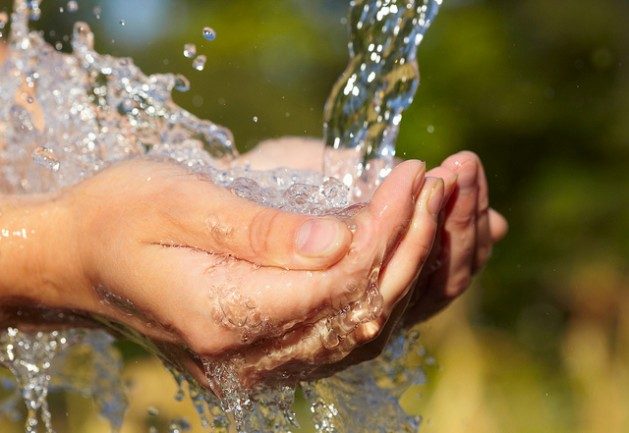Building Water Resilience Needs a Holistic Approach

BLOEMFONTEIN, South Africa, Aug 19 (IPS) - Even as COVID-19 ravages communities across the continent, climate change is widening the gap between those who have access to water and sanitation - key elements in fighting the pandemic.
We know that only about 61% of the Southern African Development Community (SADC) population has access to safe drinking water and only 39% has access to adequate sanitation facilities.
Climate change continues to widen those gaps in SADC communities where an estimated 44 million people are food insecure. Climate change may have been a looming disaster in the past, but it has now materialised, ravaging our communities in the COVID-19 pandemic. We are compelled to act prudently, fast and sustainably.
This year’s World Water Week, held from 23-27 August under the theme “Building Resilience Faster”, recognises the need to find solutions to counter climate change and other water-related challenges.
The sustainable use of groundwater offers us a way to build resilience.
The majority of sub-Saharan Africans live in rural areas, and regionally, at least 70% of SADC inhabitants rely on groundwater. This calls for sustainable management of groundwater resources to protect vulnerable communities and strengthen them to build resilience during climate change.
However, there cannot be a silo response in our fight to build water resilience. Surface water talks to groundwater and vice versa. A holistic conjunctive approach to the utilisation of these co-existing resources is indispensable to build resilience.
As you would know, when there's no surface water, you just see soil, but it does not mean that there is no more water. It just means the water has receded into groundwater. We can build resilience if we have well streamlined and robust strategies to manage these two water resources conjunctively.
Strategies are an integral part of realising our goals. However, if strategies are not followed by implementation, then all our efforts would be futile. Sadly, we have seen a regional trend where a lot of projects in SADC countries are piloted – and remain pilot projects, year after year.
We cannot afford to have designs that gather dust. We have pilots that demonstrate the viability of certain innovative principles and methodologies that have not reached the level of being upscaled or replicated. This means that these innovations do not reach the point of application where they could contribute to water security for the communities’ livestock, industrial development and other human settlement activities that support people's livelihoods.
Yes, some challenges impede the successful implementation of projects including the lack of capacity and finances. However, the challenge of supporting the region’s growing population of impoverished communities amidst dwindling resources is a daunting task that we need to overcome.
SADC-GMI has seen the tangible impact of safeguarding and uplifting communities through our pilot projects implemented at community level to provide groundwater. In Chimbiya Trading Centre, in the Dedza District, Malawi, a 100-metre deep borehole was drilled and equipped to supply potable water to about 15 000 people who benefit from the groundwater for their livelihood activities. This project boosted the economy of the local trading centre. The vision is to upscale this project model in Malawi to other communities across the SADC region to help build resilience.
Besides Malawi, we have also piloted innovative infrastructure projects to benefit communities in eight other SADC Member States. SADC-GMI constantly strives to demonstrate groundwater’s invaluable role in building resilience through its sustainable use in the communities’ livelihood and WASH activities.
Development is a collaborative process. SADC-GMI has partnered with River Basin Organisations and national water ministries across the SADC region to drive their mandate of promoting sustainable groundwater management and provide solutions to groundwater challenges in the SADC region.
At the core of our strategy is the continued endeavour to involve the very community members that we serve. Communities’ customs and traditions have been around much longer than any strategy that SADC-GMI may hope to implement to serve them. We, therefore, leverage citizen science and the knowledge that they have in supporting their communities in changing conditions.
Capacity-building is an integral part of building resilience in communities. SADC-GMI partnered with World Vision Zimbabwe to offer groundwater relief in the drought-prone Dite and Whunga communities in Zimbabwe.
The communities have committees that are greatly involved in the management of the borehole infrastructure and growing vegetables in the community gardens to support their local economy and livelihoods. Collaborative efforts such as these provide holistic and sustainable management of water resources.
SDG 6 is summarised by the United Nations (UN) as ensuring “availability and sustainable management of water and sanitation for all. Our work in the water sector – including groundwater should ensure pivotal contributions to the achievement of SDG 6.
If COVID-19 has taught us anything, is that we need to proactively respond to the challenges we face. It has also taught us that we can successfully overcome these difficulties. Our actions need to be fast yet measured and should be inclusive of the people we intend to serve. That way, we can build water resilient communities.
James Sauramba is the Executive Director of the Southern African Development Community Groundwater Management Institute (SADC-GMI)
© Inter Press Service (2021) — All Rights Reserved. Original source: Inter Press Service
 Global Issues
Global Issues